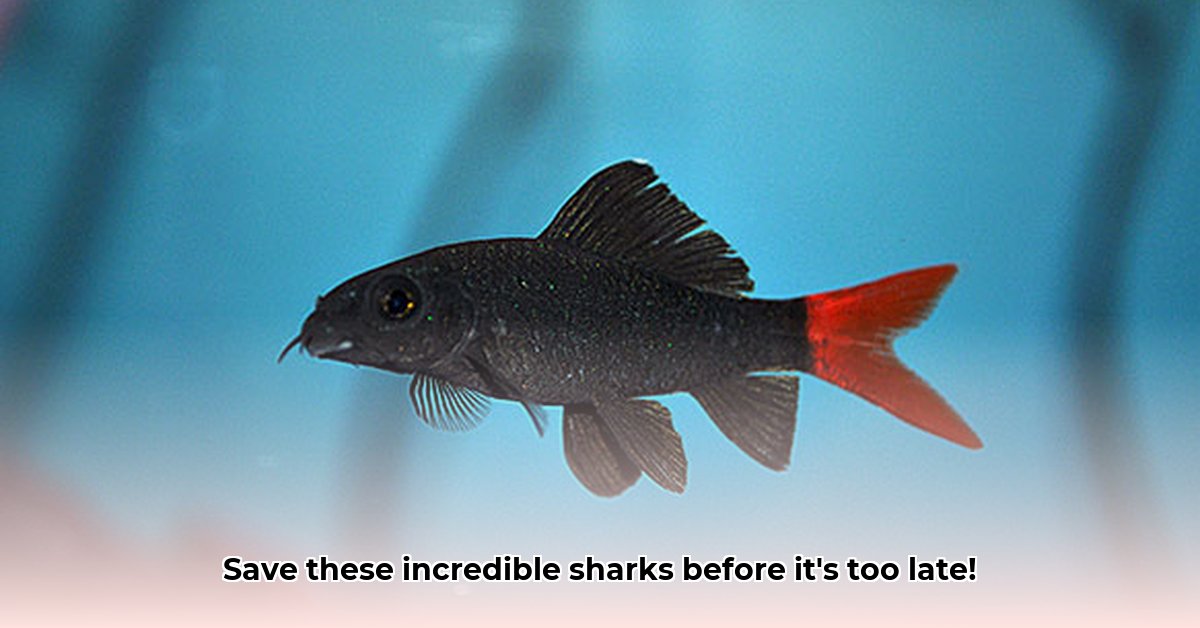The red-tailed black shark, with its striking jet-black body and vibrant red tail, is a captivating freshwater fish. Sadly, this unique species is critically endangered in its native Thailand due to habitat destruction and pollution. Learn more about endangered species here. This comprehensive guide equips you with the knowledge to provide exceptional care for red-tailed black sharks in the aquarium while contributing to their conservation.
Creating the Ideal Aquarium Environment
Replicating the red-tailed black shark’s natural habitat is key to its well-being in captivity. This involves careful consideration of tank size, filtration, substrate, decor, and water parameters.
Tank Size: A minimum 55-gallon tank is essential for a single adult red-tailed black shark. Larger tanks (75 gallons or more) are strongly recommended, especially if housing multiple sharks or other tank mates. Ample space minimizes territorial disputes and allows these active fish to exhibit their natural swimming behaviors. A cramped environment can lead to stress, aggression, and disease susceptibility.
Filtration and Water Flow: Invest in a high-quality, powerful filter capable of maintaining excellent water quality. Red-tailed black sharks thrive in well-oxygenated water with a moderate to strong current, mimicking their native river habitats. Regular filter maintenance, including cleaning and replacing filter media, is crucial to prevent the buildup of harmful toxins. Supplemental aeration, such as an air stone, can further enhance oxygen levels and water movement.
Substrate: Select smooth gravel or sand as a substrate. Sharp substrates can injure the shark’s delicate fins and underbelly, leading to infections. A dark-colored substrate helps enhance the shark’s vibrant colors and creates a more natural-looking environment.
Decor and Hiding Places: Incorporate smooth rocks, driftwood, and robust live plants to create a stimulating and secure environment. These elements provide hiding places, visual barriers, and opportunities for exploration, reducing stress and minimizing aggression. Caves, formed by rocks or driftwood, are particularly appreciated by red-tailed black sharks. Live plants not only enhance the aesthetics of the aquarium but also contribute to oxygenation and provide natural filtration. Ensure that all decor is free of sharp edges or rough surfaces that could harm the shark.
Water Parameters: Maintaining stable water parameters is critical for the red-tailed black shark’s health. Aim for a temperature range of 72-79°F (22-26°C), a pH of 6.5-7.5, and moderate water hardness (5-15 dH). Regular water changes (25-50% weekly) help maintain optimal water quality and prevent the buildup of nitrates and other harmful substances. Use a reliable aquarium test kit to monitor water parameters regularly and make adjustments as needed.
Nutrition and Compatible Tank Mates
Providing a balanced and varied diet, along with carefully selecting tank mates, are crucial aspects of red-tailed black shark care.
Diet: Red-tailed black sharks are omnivores and require a diverse diet to thrive. Offer a high-quality flake food or sinking pellets as a staple, supplemented with occasional live or frozen foods like bloodworms, daphnia, and brine shrimp. Blanched vegetables, such as zucchini, spinach, or peas, can also be offered. Avoid overfeeding, as this can lead to water quality issues. Feed small amounts two to three times daily.
Tank Mates: Choosing compatible tank mates is essential due to the red-tailed black shark’s semi-aggressive nature. Avoid housing them with other red-tailed black sharks, especially in smaller tanks, as they can become territorial and aggressive towards their own kind. Also, avoid fish with similar coloration or body shape, such as rainbow sharks, as this can trigger aggression. Suitable tank mates include fast-swimming, mid-to-upper dwelling species like barbs, danios, tetras, gouramis, and some larger, peaceful cichlids. Always monitor interactions closely and be prepared to separate fish if aggression becomes a problem.
Health, Breeding, and Conservation Efforts
Understanding potential health issues, the challenges of breeding, and the importance of conservation contributes to responsible red-tailed black shark ownership.
Health: Red-tailed black sharks are susceptible to common freshwater fish diseases like Ich (white spot disease) and fin rot. Maintain excellent water quality and a stress-free environment to minimize the risk of illness. Observe your shark regularly for signs of disease, such as lethargy, loss of appetite, discoloration, or unusual markings. Streptococcus iniae is a bacterial infection of particular concern for red-tailed black sharks. If you suspect your shark is ill, consult a veterinarian specializing in aquatic animals or an experienced aquarist for diagnosis and treatment.
Breeding: Breeding red-tailed black sharks in home aquariums is exceptionally challenging and rarely successful. Their natural breeding habits are poorly understood, and they require specific environmental cues and conditions for successful reproduction. Most red-tailed black sharks available in the aquarium trade are captive-bred on farms, often using hormone injections to induce spawning. This process is stressful for the fish and can result in high mortality rates.
Conservation: The red-tailed black shark is critically endangered in the wild due to habitat loss, pollution, and potentially over-harvesting for the aquarium trade. By choosing captive-bred sharks from reputable breeders, you can help reduce pressure on wild populations. Support conservation organizations working to protect their natural habitats and promote sustainable practices. Educate yourself and others about the importance of responsible aquarium ownership and the threats facing this remarkable species. By taking an active role in their conservation, you contribute to the long-term survival of the red-tailed black shark.
- Revolution Space: Disruptive Ion Propulsion Transforming Satellites - April 24, 2025
- Race Through Space: Fun Family Game for Kids - April 24, 2025
- Unlocking the Universe: reading about stars 6th grade Guide - April 24, 2025
















